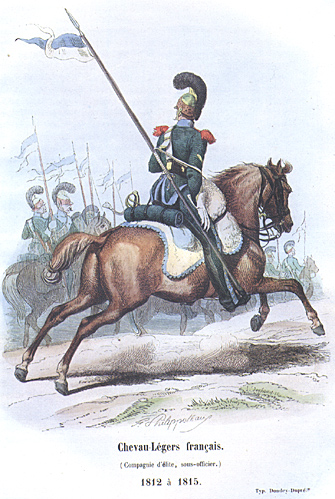Empires, Eagles and Lions is proud to present our newest column ... with all due respects to Monty Python for the title. In this column we intend to venture away from the purely researched and "dead-on accurate" facts as presented elsewhere in the magazine. It is here that you the readership can present your own theories on how and why things happened during the Napoleonic period without having fully substantiated your facts. This column will aid those whose questions are sound but may have been intimidated by the type of articles contained elsewhere. So get out those pens, pencils, and computers and begin typing ... you now have a place to present your theory and have researched into fact!
Were the majority of European Lancers based on Polish cadres?
A theory that I have been formulating ever since I became truly involved in the research of the Napoleonic period is that the majority of the Lancer / Uhlan regiments formed on the continent (excluding the Spanish and the Cossacks who, in my opinion, were not truly Lancers though many were indeed Polish) were either entirely Polish or based on Polish cadres.
FRANCE AND HER ALLIES
I will start off where it's the easiest, Poland / Lithuania where ALL the lancer regiments formed were Polish with a sprinkling of German troopers this includes the Krakus regiment and the Polish Chasseur a Cheval whom carried lances at both the beginning and end of their existence. Now on to France and her lancer regiments. The Lanciers Polonaise de la Garde and Lithuanian Tartars were definitely Polish as were the officers and "drill sergeants" of the Dutch Lancers of the Guard, those being selected from the Poles and paid as Old Guard. The 7th, 8th, and 9th lancers of the line were originated as follows ... the 7th and 8th were the ex-Vistula lancers and most certainly of Polish origin. The 9th Lancers being based on the 30th Chasseurs a Cheval were mostly German in make up but had a high percentage of Polish officers and NCO's forming up as their cadre. The Lanciers de Berg were based on the Polish honor guard that Murat had recruited for himself during his stay in Warsaw. When Napoleon sent him to Berg he took this guard and eventually formed the Berg Lancers from this cadre.
PRUSSIA
Prussia's Lancer / Uhlan regiments were initially created from the Towarczys and of Polish origin. As she expanded her regiments of Uhlans during the "fight for German liberation' a preponderance of the troopers were recruited from the Landwher throughout Prussia. Now, while I have no researched basis, I believe that a large number of those recruits (particularly in 1813) were taken from recently 'recovered' Polish territories and included many ex-army personnel.
AUSTRIA
Does 'Galicia' ring a bell? Many of the officers and men of the Austrian Uhlan regiments were of Polish origin as was the case with each of the nations that participated in the partitioning of Poland ... Austria , Prussia, and Russia.
RUSSIA
Lastly for the basis of our discussion we can cover Mother Russia. Many of her lancer / uhlan regiments were composed primarily of Poles ... quite a few of whom were serving voluntarily. Even if for arguments sake we consider the Cossacks as 'true' uhlans the case could be made that as far back as 1500 the stock of the Cossacks was at least 40% Polish in origin. Thus even those units entirely raised of Russian citizens were in part Polish.
As this is the first of a hopefully long running column. But like all the columns and sections that are found in E,E, & L it depends upon the readership to take part and make this successful. Nothing written above is set in stone and my skin is not so thin that I can't take a re-buff. Please feel free to comment and educate the readership.

Back to Empire, Eagles, & Lions Table of Contents Vol. 2 No. 1
Back to EEL List of Issues
Back to MagWeb Master Magazine List
© Copyright 1993 by Emperor's Headquarters
This article appears in MagWeb (Magazine Web) on the Internet World Wide Web.
Other articles from military history and related magazines are available at http://www.magweb.com
